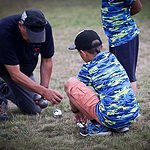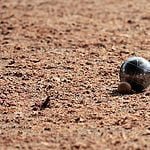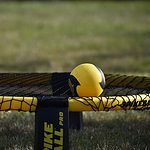Have you ever wondered what secrets your badminton racket might hold within its slender frame? Beyond the strings and grip, nestled on the cone of your racket, lies a series of characters that are more than just a random assortment of letters and numbers.
This code, often overlooked, is the key to unlocking the history and authenticity of your badminton companion. As a professional, you're aware that the devil is in the details, and it's these details that can differentiate a genuine racket from a counterfeit one.
By understanding the significance of these codes, you'll not only ensure you're using legitimate equipment but also gain insight into the manufacturing nuances that might affect your game.
Now, let's consider the implications of this code and how it can influence your choices, both on and off the court.
Key Takeaways
- The manufacturing code on the cone of a badminton racket reveals the production date and country of origin.
- Genuine rackets have a laser-engraved code, while counterfeits may have printed codes.
- Interpreting the production code helps identify counterfeit rackets, and irregularities in the code may indicate a fake product.
- Checking for matching serial numbers, hologram stickers, lettering appearance, barcode stickers, and physical feel can further confirm the racket's authenticity.
Decoding the Racket's Identity
To decode your badminton racket's identity, begin by examining the laser-engraved production code on the cone, which reveals the manufacturing date and country of origin. This alphanumeric sequence is your racket's unique fingerprint. The first five digits encode the production date. For example, '12064' would translate to 2012, June 4th. The last digit signifies the country where the racket was manufactured, with each number corresponding to a specific country.
Authenticity is further confirmed by cross-referencing the serial number found above the cone on the shaft. It must correlate with the cone's numbers. Yonex, a leading brand, employs rigorous quality control, ensuring that each racket's serial number is defect-free. Any discrepancy between these numbers should raise a red flag about potential counterfeit products.
Bear in mind, the grip size, an essential factor for player comfort and performance, doesn't relate directly to the production code but is another aspect to verify when assessing a racket. The grip size, usually indicated by a 'G' followed by a number, such as 'G4', determines the circumference of the racket handle. Ensure you're holding a racket that fits your hand snugly for optimal control and power in your game.
Significance of the Manufacturing Code
Understanding the manufacturing code on your badminton racket is crucial for verifying its authenticity and origin. This engraved set of digits, located on the cone, reveals the exact production date and country code, which are indispensable for distinguishing genuine products from potential counterfeits. Genuine rackets possess a laser engraved code, a feature that counterfeiters often overlook, opting instead for printed codes that are much easier to fabricate.
The first five digits of the manufacturing code specifically denote the production date. This precise information allows you to ascertain the manufacturing timeline of your racket. The last digit, representing the country code, offers insight into where the racket was crafted, adding another layer to its traceability.
By verifying the manufacturing code, you're engaging in a vital step to ensure you're wielding an authentic racket. Not only does this safeguard your investment, but it also guarantees you're playing with equipment that meets the high-quality standards set by the brand.
Be vigilant for any irregularities within the manufacturing code, as these may signal a questionable source or counterfeit product. Remember, a consistent and accurate code is a testament to a racket's legitimacy, making the verification process much easier and more reliable.
Understanding the Serial Number
Your badminton racket's authenticity hinges on a serial number, typically located above the cone on the shaft, which should correspond with the production code to confirm the racket's genuineness. Interpreting production codes is vital in identifying counterfeit rackets. The first five digits of the production code laser engraved on the cone indicate the production date, while the last digit represents the country of manufacture.
To ensure you're holding a genuine article, the importance of matching serial numbers cannot be overstated. Here's a breakdown of what to check:
| Feature | Genuine Indicator | Counterfeit Indicator |
|---|---|---|
| Serial Number | Matches cone number | Does not match |
| Hologram Sticker | Present with verifier | Absent or unverifiable |
| Lettering Appearance | Sharp and precise | Often blurred or inconsistent |
| Barcode Sticker | Underneath the original grip | Missing |
| Physical Feel | Stiff when twisted | May feel flimsy or overly flexible |
Authenticity Verification Methods
Verify your Yonex racket's authenticity by meticulously examining the production code etched on the cone, ensuring it's laser-engraved rather than printed. This detail is vital for verifying legitimacy, as counterfeit rackets often have codes that are merely printed on. The first five digits of this code reveal the production date, while the last digit corresponds to the country code where the racket was manufactured.
For further counterfeit detection, inspect the hologram sticker positioned on the cone. Utilize the Yonex Authenticity Verifier to confirm the presence of Yonex lettering when viewing the hologram from a specific angle. Authentic rackets display a particular pattern and color shift within the hologram that counterfeit products can't replicate.
Additionally, look for the barcode sticker beneath the racket's grip. Genuine Yonex rackets will have this sticker in place, providing additional validation of authenticity.
Lastly, evaluate the racket's physical attributes—the stiffness of the frame, the quality of the materials, and the craftsmanship should meet the high standards Yonex is known for. These tactile and visual cues are critical in distinguishing between a genuine Yonex racket and a counterfeit one.
Interpreting Date and Batch Codes
To accurately determine the production date and origin of your badminton racket, decode the first five digits of the laser-engraved production code found on the cone, with the final digit revealing the country of manufacture. Interpreting production codes is critical for assessing the racket's authenticity and ensuring you're using a product manufactured to the highest standards.
When inspecting your racket, here are key points to remember:
- Production Date: The first two digits indicate the year, and the following three digits signify the day of that year.
- Country Code: The last digit of the code identifies the country where the racket was produced.
- Batch Codes: Analyzing batch codes provides insight into the specific production run, which can be useful for quality assurance purposes.
- Decoding Manufacturing Dates: This process helps you verify the racket's age and potentially its warranty status.
Keep in mind that a genuine racket will also have a hologram sticker and a barcode sticker underneath the grip. Pay attention to these features along with the physical feel of the racket to confirm its authenticity. Accurate decoding ensures you can trust the tool in your hands during play.
Impact of Codes on Player Selection
Deciphering the production codes on badminton rackets can significantly influence players' selection process, ensuring they choose equipment that's not only authentic but also matches their performance requirements. The impact on player performance is profound; a genuine racket tailored to a player's style can enhance precision, control, and power. It's why understanding code analysis techniques is paramount.
Serial numbers on the shaft and cone, coupled with hologram stickers, are vital in confirming the racket's legitimacy. A mismatch or absence of these indicators can lead to suboptimal equipment choices, adversely affecting gameplay. Code tracking and monitoring, therefore, become essential components in a player's arsenal to safeguard against counterfeit rackets that could compromise performance.
Moreover, the code can reveal the racket's production batch, which, when cross-referenced with known performance characteristics of that batch, can assist you in selecting a racket with the desired flex and balance. A meticulous visual and tactile inspection, supported by code verification, ensures you're wielding a tool that elevates your game.
Spotting Counterfeits With Codes
Understanding the significance of production codes in selecting the right badminton racket, you can also use these identifiers to spot counterfeits and ensure you're not duped by a fake. Identifying counterfeit rackets through visual inspection is a critical step in authentication. Look for the following signs:
- Laser Engraved vs. Printed Codes: Genuine Yonex rackets have laser engraved codes on the cone, whereas counterfeits often have printed codes, which are easier to produce and one of the common mistakes in counterfeit racket codes.
- Correct Production Date and Country Code: Check the first five digits for the production date and the last digit for the country code. Any inconsistency is a red flag.
- Hologram Sticker Verification: A hologram sticker should be present on the cone with specific Yonex lettering, verifiable through the Yonex Authenticity Verifier.
- Barcode Sticker Presence: Underneath the grip, a barcode sticker should be visible. Its absence could signal a counterfeit.
Additionally, assess the racket's physical attributes, such as stiffness, grommets, and paint quality. For added security, emphasize the importance of purchasing rackets from authorized dealers to avoid the risk of counterfeit products.





